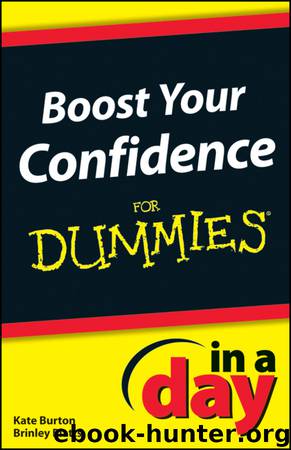Boost Your Confidence In a Day For Dummies by Kate Burton

Author:Kate Burton
Language: eng
Format: epub
Publisher: Wiley
Published: 2012-06-06T16:00:00+00:00
Tracking Your Moods
During the course of a day, you experience a number of moods – temporary states of mind or temper. Think of your moods as a temperature gauge, registering hot and cold at different times according to the weather.
Whatever mood you’re in affects your behaviour and this behaviour in turn has an impact on the results you get. When you feel energetic and enthusiastic, you naturally take on more and confidently get more done. So a real benefit can come from paying attention to how you feel. Your mood shows through your expressions and gestures as much as by what you say or don’t say, and thus has a knock-on effect on others around you.
If you’re aware that you’re not in your best frame of mind, then you know instinctively that you’re not in the best place from which to make important decisions. If your mood isn’t helpful, the quickest thing you can do is change it by changing your physical state. Have a nap or go for a run or a swim; if all else fails, have a cup of coffee.
Staying in touch with your mood patterns
As you refine your awareness of your mood and that of other people, you heighten your observation of what triggers a change in mood for you – whether for good or bad.
As you become more aware of your moods, think about the colours and hues of your underlying emotions and feelings, the fine difference in temperature that you detect in yourself and those around you.
Take a typical day in your schedule, once a week, and make a note of your mood at key points in the day – early in the morning, at midday, mid-afternoon, early evening and finally as you go to bed.
Start to pay attention to how you’re feeling and the nuances of how you describe those feelings. On the down side, you may say that you’re sad, grumpy, sullen, nervy, melancholy or cross. And when things are on the up you may be happy, content, peaceful, excited or joyful. You’ll soon see how some feelings are more conducive to confident action. Start to build your own repertoire of language to describe the subtle changes in your mood, and pay attention to what happens to trigger the change. You may then decide you want to make some changes in your day to prevent yourself dropping into a weakened state.
Becoming more aware of your natural state
When Kate (co-author of this book) is walking along, she often finds herself involuntarily humming a familiar piece of classical music – Vltava, by the Bohemian composer Smetana. Her humming transports her to a happy, sociable time when she heard it played in a concert. She takes her humming to mean that all is well with the world, she’s in a good state and that her life is flowing steadily.
Your state is more than just a mood – it’s a way of being, as opposed to a way of doing. To find your natural state, what we call your baseline state on a day-to-day basis, you need to determine your normal way of being.
Download
This site does not store any files on its server. We only index and link to content provided by other sites. Please contact the content providers to delete copyright contents if any and email us, we'll remove relevant links or contents immediately.
Professional Troublemaker by Luvvie Ajayi Jones(29427)
Whiskey Words & a Shovel I by r.h. Sin(19196)
Rewire Your Anxious Brain by Catherine M. Pittman(18325)
Healthy Aging For Dummies by Brent Agin & Sharon Perkins RN(16928)
Cat's cradle by Kurt Vonnegut(14783)
Talking to Strangers by Malcolm Gladwell(12891)
The Art of Thinking Clearly by Rolf Dobelli(9930)
They Both Die at the End by Adam Silvera(9509)
The 5 Love Languages: The Secret to Love That Lasts by Gary Chapman(9297)
Doing It: Let's Talk About Sex... by Hannah Witton(9084)
The Compound Effect by Darren Hardy(8527)
Thirteen Reasons Why by Jay Asher(8472)
Goodbye, Things by Fumio Sasaki(8301)
Wonder by R.J. Palacio(8276)
Atomic Habits: Tiny Changes, Remarkable Results by James Clear(8055)
Becoming Supernatural by Dr. Joe Dispenza(7847)
Tools of Titans by Timothy Ferriss(7828)
Wonder by R. J. Palacio(7749)
Should I Stay or Should I Go? by Ramani Durvasula(7436)
